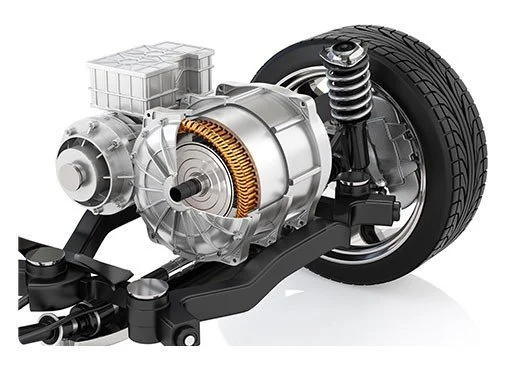The automotive industry is undergoing a revolutionary shift with the rapid adoption of electric vehicles (EVs). Unlike their internal combustion engine (ICE) counterparts, electric cars use electricity to power their systems and move.
As more consumers consider making the switch to electric, it’s essential to understand the unique parts of an electric vehicle and how each component functions to deliver a cleaner, more efficient driving experience. In this article, we’ll break down the key components of electric cars and explain their roles and functionality in detail.
1. Battery Pack: The Heart of the Electric Car
The battery pack is the most critical component of an electric vehicle, providing the energy required to power the electric motor and auxiliary systems. Most electric cars use lithium-ion batteries due to their high energy density, lightweight properties, and relatively long lifespan. The battery pack is composed of individual cells grouped into modules and encased to ensure safety and thermal management.
a) How It Works
When the vehicle is plugged in, electrical energy flows into the battery pack, charging it. The battery stores this energy in the form of chemical potential energy, which is later converted into electrical energy when the car is in operation. The capacity of an EV battery is measured in kilowatt-hours (kWh), which determines the range of the vehicle on a single charge.
- Advertisement -
b) Battery Management System (BMS)
The BMS monitors and regulates the performance of the battery pack. It ensures that the cells are charged and discharged evenly, maintains optimal temperature, and protects the battery from overcharging, overheating, or deep discharging, all of which can reduce the lifespan of the battery.
2. Electric Motor: The Power Source for Movement
The electric motor is what propels the vehicle, converting electrical energy from the battery into mechanical energy. Unlike internal combustion engines, electric motors provide instant torque, resulting in smooth and rapid acceleration. There are various types of electric motors used in EVs, including induction motors, permanent magnet synchronous motors (PMSMs), and brushless DC motors.
a) How It Works
When you press the accelerator pedal, the electric motor receives a signal from the controller to draw power from the battery. The motor converts this electrical energy into rotational motion (torque) that drives the wheels. Electric motors are highly efficient, with efficiency rates often exceeding 90%.
b) Types of Electric Motors
- Induction Motors: Commonly used in Tesla vehicles, these motors rely on electromagnetic induction to generate motion and are known for their durability and robustness.
- Permanent Magnet Motors: These motors use magnets embedded in the rotor, providing high efficiency and torque density, making them ideal for many modern EVs.
- Brushless DC Motors (BLDC): Often used in smaller EVs and electric scooters, BLDC motors are efficient and lightweight.

3. Inverter: Converting Energy for the Motor
The inverter is an essential part of an electric vehicle’s drivetrain. Its primary function is to convert direct current (DC) electricity stored in the battery into alternating current (AC) electricity required by the electric motor. Additionally, the inverter plays a crucial role in controlling the speed and torque of the motor by adjusting the frequency and amplitude of the electrical signal.
a) How It Works
When the driver accelerates or decelerates, the inverter manages the flow of electricity to ensure smooth and efficient operation. It can also reverse the current flow during regenerative braking (discussed later), converting mechanical energy back into electrical energy and storing it in the battery.
4. Controller: The Brain of the Operation
The controller acts as the brain of the electric vehicle, managing the flow of electricity between the battery and the electric motor. It interprets signals from the accelerator pedal and other sensors to control the speed, torque, and direction of the vehicle. By regulating the electrical energy delivered to the motor, the controller ensures optimal performance and energy efficiency.
a) Key Functions
- Acceleration Control: The controller determines how much power the motor needs based on the driver’s input.
- Regenerative Braking Control: When the vehicle slows down, the controller manages the process of converting kinetic energy into electrical energy and feeding it back into the battery.
5. Onboard Charger (OBC): Facilitating Charging
The onboard charger converts the alternating current (AC) electricity from a charging station or household outlet into direct current (DC) electricity that can be stored in the vehicle’s battery. The onboard charger ensures that the charging process is safe, efficient, and compatible with various charging standards.
a) Charging Levels
There are three main levels of EV charging:
- Level 1 Charging (120V AC): Suitable for overnight charging at home, providing a slow charge rate.
- Level 2 Charging (240V AC): Faster than Level 1, commonly used at home, workplaces, and public charging stations.
- Level 3 Charging (DC Fast Charging): Provides rapid charging, often recharging 80% of the battery in 30-60 minutes. This level is typically found at highway rest stops and public charging hubs.
6. Thermal Management System: Keeping Everything Cool
Electric vehicles generate heat, especially during high-speed driving, rapid acceleration, or fast charging. To maintain optimal performance and safety, EVs rely on a thermal management system that regulates the temperature of the battery, electric motor, and other components.
a) Cooling and Heating Mechanisms
- Liquid Cooling Systems: Circulate a coolant through the battery pack and motor to absorb and dissipate heat.
- Air Cooling Systems: Use fans to circulate air around key components to reduce heat buildup.
- Heat Pumps: Some EVs use heat pumps to provide cabin heating more efficiently than traditional resistive heaters, reducing energy consumption and extending driving range.
7. Regenerative Braking System: Energy Recovery
One of the unique features of electric vehicles is regenerative braking, which captures and stores energy that would otherwise be lost as heat during braking. Regenerative braking slows down the vehicle by reversing the direction of the electric motor, converting kinetic energy into electrical energy that is fed back into the battery.
a) How It Works
When the driver lifts their foot off the accelerator or applies the brake pedal, the regenerative braking system activates. The motor switches to generator mode, capturing the vehicle’s kinetic energy and converting it into electrical energy. This process improves energy efficiency and can extend the driving range of the vehicle.
8. Transmission System: Simplified and Efficient
Unlike traditional vehicles with complex multi-speed transmissions, most electric cars use a single-speed transmission or gearbox. Electric motors produce a wide range of torque across different speeds, eliminating the need for multiple gears.
a) How It Works
The single-speed transmission transfers power from the electric motor to the wheels, providing smooth acceleration and efficient power delivery. This simplicity reduces maintenance costs and enhances overall vehicle reliability.
9. Charging Port: Connecting to Power Sources
The charging port is the interface between the electric vehicle and an external power source. It allows the vehicle to connect to charging stations for energy replenishment. Different regions and manufacturers use various charging standards and connectors, such as CHAdeMO, CCS (Combined Charging System), and Tesla Supercharger.
a) Types of Charging Connectors
- Type 1 (J1772): Commonly used in North America for Level 1 and Level 2 charging.
- Type 2 (Mennekes): Widely used in Europe and supports single-phase and three-phase charging.
- CHAdeMO: A fast-charging standard used by some Japanese automakers.
- CCS (Combo Connector): Combines AC and DC charging capabilities in one connector, offering fast charging.
- Tesla Supercharger: Proprietary connector used by Tesla vehicles for fast DC charging.
10. Infotainment and User Interface Systems
Modern electric vehicles often come equipped with advanced infotainment systems that provide real-time information on battery status, range, charging stations, energy consumption, and more. These systems are typically controlled via a touchscreen interface and may include navigation, entertainment, and connectivity features.
a) Connected Car Features
Many EVs offer connected car features that allow owners to monitor and control their vehicle remotely via a smartphone app. Functions may include remote charging management, climate control pre-conditioning, and locating the vehicle.
11. Electric Vehicle Architecture and Design
Electric vehicles differ from internal combustion vehicles in terms of architecture and design. The absence of a traditional engine allows for more flexible vehicle designs, such as flat floors, larger interiors, and improved aerodynamics.
a) Skateboard Platform
Many EVs are built on a “skateboard” platform, where the battery pack is placed beneath the vehicle’s floor. This design lowers the vehicle’s center of gravity, improving stability and handling.
b) Lightweight Materials
To enhance energy efficiency and offset the weight of heavy batteries, many EVs use lightweight materials such as aluminum, carbon fiber, and high-strength steel.
12. Advanced Driver-Assistance Systems (ADAS)
Many electric vehicles are equipped with advanced driver-assistance systems that enhance safety and provide semi-autonomous driving capabilities. These systems rely on sensors, cameras, and radar to monitor the vehicle’s surroundings and assist the driver.
a) Key Features of ADAS
- Adaptive Cruise Control (ACC): Maintains a safe distance from the vehicle ahead.
- Lane Keeping Assist (LKA): Helps the driver stay in their lane.
- Automatic Emergency Braking (AEB): Applies brakes if a collision is imminent.
- Parking Assist: Helps with parallel and perpendicular parking.
13. Conclusion: Building a Sustainable Future with Electric Cars
Electric vehicles are more than just an environmentally friendly alternative to traditional cars; they represent a

